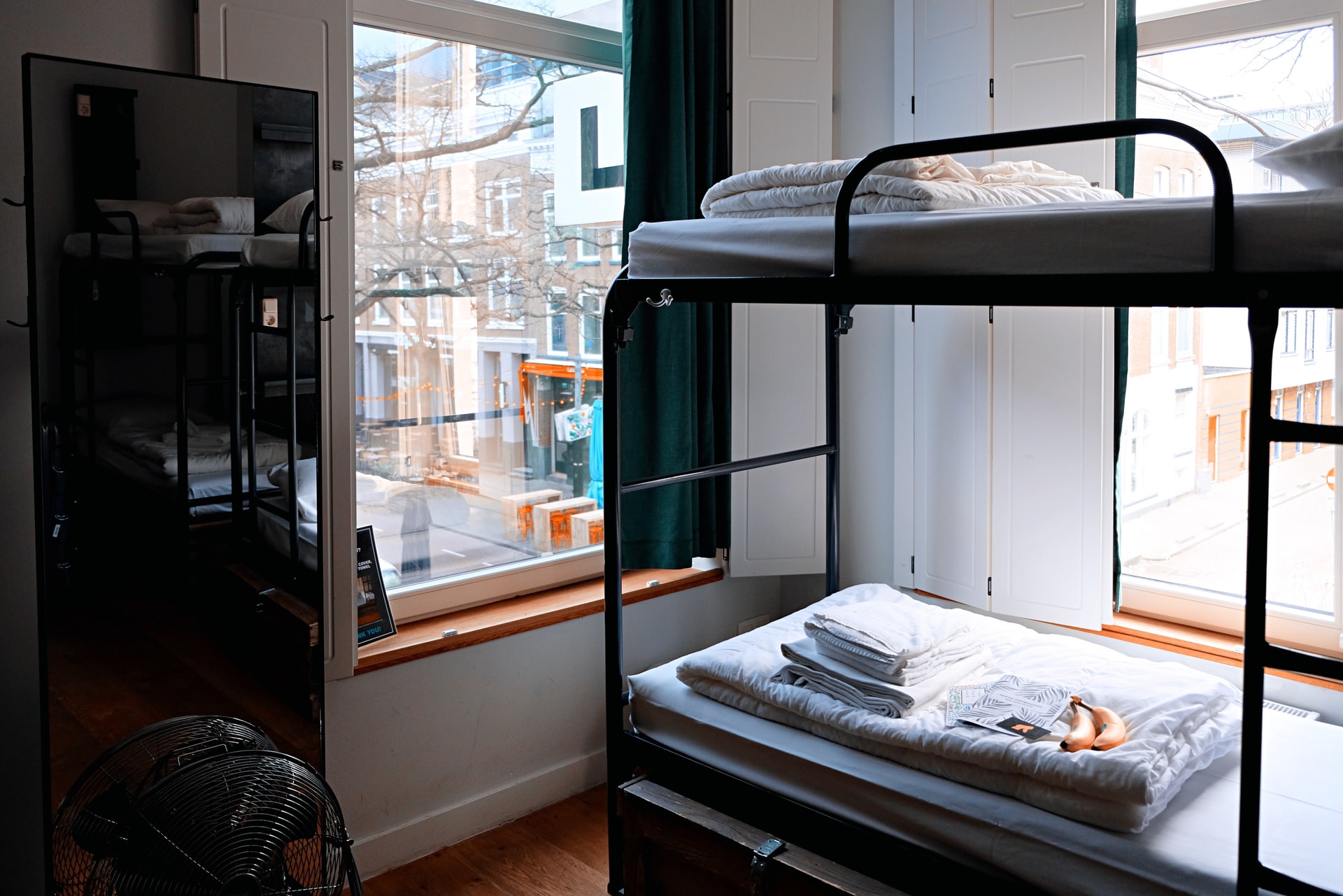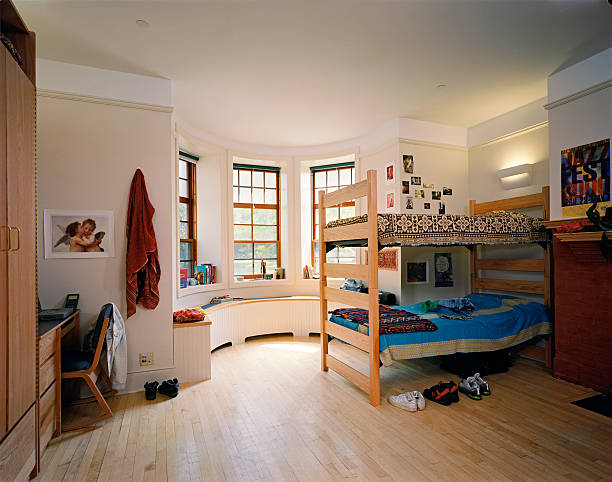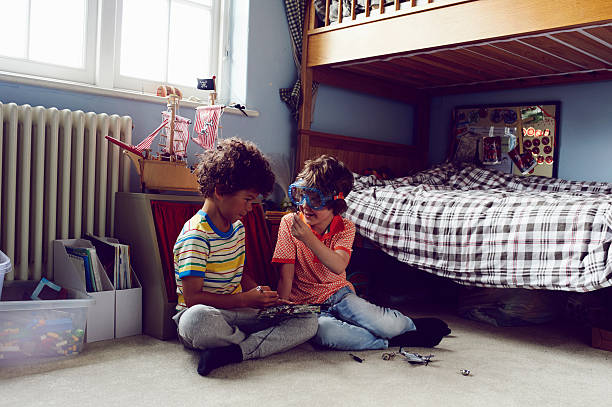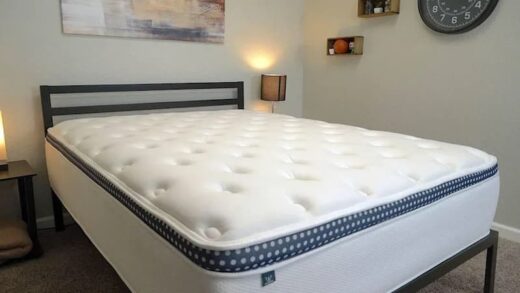What Is The Size Of A Bunk Bed? With Different Types Of Bunk Beds

The answer for this question is that a Standard, Single, or Twin bunk bed measures 75 in. x 39 in. x 65 in. A Full bunk bed or Double bunk bed is 75 in. x 54 in. x 65 in. Other bunk bed sizes include short bunk beds, triple bunk beds, and bunk beds with trundles. Queen and King bunk beds are uncommon.
Bunk beds, like regular platform beds, come in a variety of sizes. In many situations, the top and bottom bunks are of different sizes. The top bunk is generally smaller (normally a Twin) than the bottom bed (usually a Full or larger). Bunk beds are normally made of solid wood, metal, or a mix of the two to make them sturdy enough to handle the weight of two or more people.
Because bunk beds save so much sleeping space, they’re quite common in shared rooms with two or more people. Bunk beds are commonly seen in communal sleeping areas such as youth hostels, ships, military barracks, student dorms, and summer camps. It’s also a wonderful bed arrangement for siblings. So, if you’re a parent looking to save on bedroom space for your children, purchase them bunk beds rather than single beds!
Table of Contents
What’s the size of a bunk bed?
The first two bunk bed dimensions listed below correlate to the lengths and widths of approved standard mattress dimensions, with a third measurement relating to the height of the bunk bed when constructed. The term ‘as assembled’ refers to the dimensions including the entire height of the bunk bed to the top of the posts.
A Standard, Single, or Twin bunk bed measures 75 in. x 39 in. x 65 in. Other sizes of bunk beds are available. A Full bunk bed or Double bunk bed is 75 in. x 54 in. x 65 in. A Queen bunk bed measures 80 in. x 60 in. x 65 in. A King bunk bed measures 80 in. x 76 in. x 51.5 in. Keep in mind that a ‘King’ bunk bed typically means the bottom bunk is a king and the top bunk is a twin. On the top bunk, it’s unusual to find a bed larger than a full size bed.
Some of the other typical mattress sizes listed below are uncommon for ready-to-assemble bunk beds, but they are still viable possibilities for custom-built bunk bed projects.
A narrow or 3-foot mattress bunk bed measures 36 in. x 75 in. x 65 in. A Twin Extra Long or Twin XL bunk bed measures 39 in. x 80 in. A California Queen bunk bed measures 60 in. x 84 in. x 65 in. An Expanded Queen bunk bed measures 66 in. x 80 in. x 65 in. A California King bunk bed is 72 in. x 84 in. x 65 in., while a Grand King bunk bed measures 80 in. x 98 in. x 65 in. These sizes are quite unusual.
The sizes of bunk beds are represented in the below:
Bunk Beds for Twins
A twin mattress measures 38 inches broad by 75 inches long. Two twin beds are put on top of each other in a normal twin bunk bed. These are popular in children’s bedrooms and offer a terrific way to save space.
Bunk beds with twin XL mattresses (38 inches wide and 80 inches long) are ideal for college dorm rooms. Twin XL bunk beds are comfortable for full-grown people due to the longer mattresses.
Full Size Bunk Beds
Full bunk beds are identical to twin bunk beds, except they accommodate full mattresses. Full size mattresses are 53 inches broad and 75 inches tall, making them ideal for single sleepers such as teens or college students.The bottom bunk is usually a full size bed, while the top bunk is usually a normal twin mattress.
Bunk Beds for Queens
Queen beds measure 60 inches broad by 80 inches height. These bunk bed mattresses are ideal for two people sharing a bed or for one adult who needs a lot of space to move around. Typically, the bottom bunk has a queen size mattress, while the top bunk has a twin mattress.

New Bunk Bed Dimensions
A bunk bed is an excellent method to save space in a bedroom. To that end, there are several creative bunk bed designs with distinctive bed frame proportions available.
Some of these frames also double as wardrobes, desks, or seating places. Others have trundle beds, additional storage space, or built-in drawers.
Bunk Beds for Kids
A shorty bunk bed is similar to a conventional twin bunk bed, however it is shorter (hence the name). A standard shorty bunk is 412 feet tall. Parents like these frames for their younger children since the top bunk isn’t as high off the ground, making a kid tumble over the side of the bed less perilous.
For suggestions on what mattresses to combine with a shorty bunk bed in a children’s room, consult our Best Mattress for Kids guide.
Instead of two levels of beds, triple bunk beds have three. These bunks may be up to 712 feet tall, therefore a high ceiling is essential so that the person on the top bunk has enough of overhead room. While not suitable for little children, these bunk beds are ideal for adolescent or young adult bedrooms.
Bunk Beds in an L-Shape
These one-of-a-kind bunk beds are an innovative way to fit up to three people in one bedroom. The L-shaped upper bunk accommodates two people. Typically, there is only one bottom bed, providing plenty of room for a desk or lounging area.
The top bunk is often intended to accommodate two twin beds, while the bottom bunk can accommodate a twin, full, or queen mattress. L-shaped bunk beds are a hybrid of a bunk bed and a loft bed. These frameworks often stand 512 to 6 feet tall.
How long do conventional bunk beds last?
According to the data above, ordinary bunk beds are around 80 inches long when completed and can fit normal mattresses 75 inches long.
Shorty bunk beds are also roughly 80 inches long because, although being several inches closer to the ground, a shorty bunk bed will still use a single, twin, or standard-sized mattress that is 75 inches long.
What is the maximum height of a bunk bed?
Because there are no industry standards for bunk bed height, any manufacturer may build their bunk beds as low or tall as they wish.Having said that, the majority of bunk beds are between 50 and 65 inches height, with the highest triple beds typically topping 77 inches tall.
In general, most regular bunk beds are around 65 inches height. This height is based on the uppermost component of the top bunk, which is generally the guard rail, while the top of the mattress is normally a few inches below.
Because the height of a bunk bed might effect how well it fits within your room, you should consider the overall floor space available in the bedroom where the bunk bed will be installed.
As a general rule, larger rooms can handle larger mattresses, whilst smaller rooms can benefit from smaller bunk beds.
So, as precisely as possible, measure your available floor space. Nonetheless, it is a good idea to allow for an inch or two of error when measuring for any inconsistencies in the company’s production requirements or the precision of your manual measurement.
There is no official manufacturer’s recommendation for overall ceiling height, but it is commonly acknowledged that in order for an adult to comfortably sit in bed, there must be between 33 inches and 38 inches of clearance from the top of the mattress on the highest bunk to the ceiling. Using this idea, if you have a bunk bed that is 65 inches tall and the top of the mattress is a few inches below, an 8 foot or 96 inch ceiling will sufficient.
What size are camper bunk beds?
Because there are no standard standards, the size of a camper or travel trailer will vary by manufacturer. As a result, the size of bunk beds for campers will vary, but because space is limited, it is customary for campers to use standard or full sized mattresses for their bunk beds. Mattress sizes in an RV, camper, or trailer, on the other hand, generally relate to RV mattress sizes, which differ slightly from regular house mattresses.
Bunk bed mattresses for campers come in a variety of sizes. An RV bunk bed mattress can even be as little as 75 in. x 28 in. An RV Twin or Standard may be 75 in. x 38 in. or 80 in. x 38 in. in size. The dimensions of double bunk beds for campers or RVs are 75 in. x 54 in. As a result, it’s still essential to consult your manufacturer’s specifications to determine the size of your RV mattress.
The height of the top bunk is totally determined by the overall ceiling height of the trailer or camper. Campers can have ceiling heights ranging from less than 7 feet to 10 feet or more, therefore bunk bed heights will be lower in trailers with lower ceilings and higher in campers with higher ceilings.

What size is a shorty bunk bed?
While the word “shorty” bunk bed is not an official term, it refers to a low bunk bed designed specifically for children. Most shorty bunk beds have a narrow or 3 ft. mattress, which is somewhat smaller than a standard or twin mattress. Please see the table above.
The first two measures of the shorty bunk bed dimensions shown below correspond to the lengths and widths of the mattresses used, with a third value referring to the height of the bunk bed when built.
A twin sized shorty bunk bed mattress is 75 in. x 36 in. x 50 in. This is the 3-foot mattress that is commonly used for children’s bunk beds. There are also shorty bunk beds that use a regular twin size mattress and have measurements of 75 in. x 38 in. x 50 in. The height of the bed typically fluctuates between 50 and 55 inches, making a shorty at least 10 inches shorter than the regular height of standard adult bunk beds.




















![Silk & Snow Hybrid Mattress Review Should You Buy It Or Not [2022]](https://www.myspacebeds.com/wp-content/uploads/2022/11/Silk-Snow-Hybrid-Mattress-Review-Should-You-Buy-It-Or-Not-2022-520x293.jpg)
